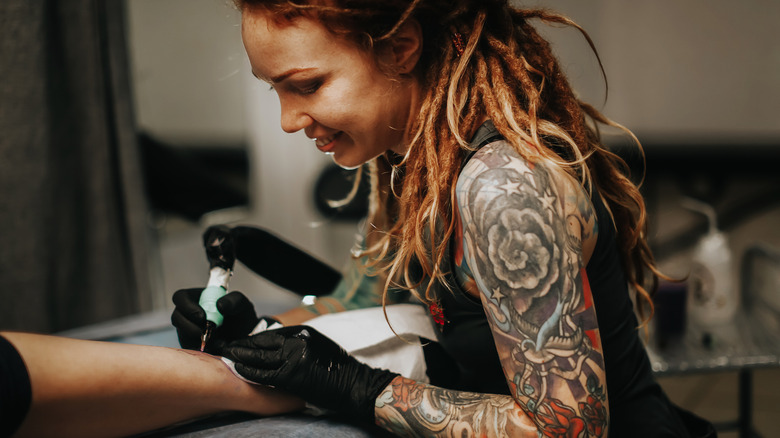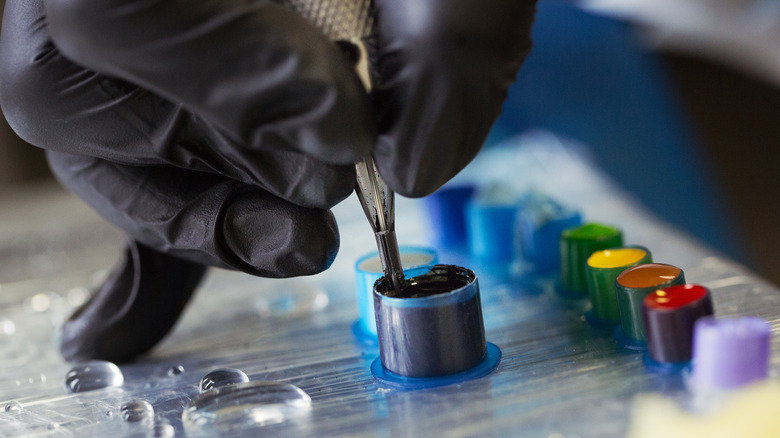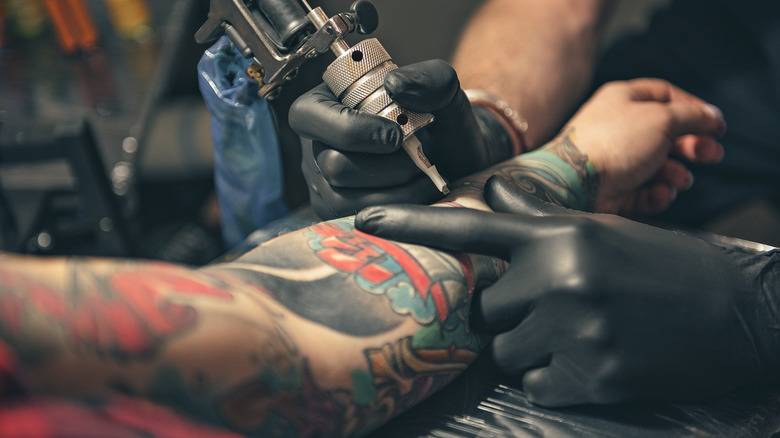Here's What Tattoo Ink Is Really Made Out Of
About one-third of Americans have at least one tattoo, reports the market research firm Ipsos. Today, this practice is no longer taboo. "People get tattoos for many reasons. Sometimes to commemorate a loved one. To mark an important journey or event in their life. To cover scars from accidents. Whatever the reason is, tattoos are a form of self-expression and seem to be much more accepted by society than they once were," said Dr. Elena Merenda in a February 2020 interview with Ignite.
Surprisingly, few people know what tattoo ink is made out of. Even fewer are aware that some pigments can travel through the body and build up in the liver (per Dermatology). Tattoo ink goes deep into the skin, which allows it to last over the years. Some of it may reach the bloodstream and make its way to the lymph nodes. The remaining pigment is gradually decomposed over time in response to sunlight. It's estimated that 87 to 99% of ink pigments fade in the next few months or years after tattooing, according to a 2015 review published in Karger.
As you would expect, tattoo inks vary in quality. Some brands are 100% organic, while others may contain heavy metals and chemicals. But these products are not regulated by the FDA, and little is known about their safety. With that being said, let's take a closer look at the ingredients in tattoo inks.
The truth about tattoo ink ingredients
There are hundreds of tattoo ink brands on the market, and each uses different ingredients. A 2016 study conducted by the Joint Research Centre (JCR) reports that more than 100 pigments and 100 additives are currently in use (per the European Commission). About 60% of pigments may release aromatic amines, a class of compounds with carcinogenic effects. Over 40% of all tattoo products tested by the JCR contained polycyclic aromatic hydrocarbons (PAHs), while 14% had aromatic amines in their composition. Others had traces of heavy metals and contaminants.
Animal studies suggest that PAHs, such as benzo[a]pyrene, may lead to cancer and reproductive defects, warns the Illinois Department of Public Health. However, these potential side effects have not been observed in humans. Tattoo ink, especially red pigments, may contain mercury, iron, cadmium, and other toxic metals. These compounds can cause dermatitis, skin inflammation, rashes, itching, and allergic reactions, notes a 2016 review published in Dermatology and Therapy.
Blank ink is typically made from bone char, iron oxide, carbon, and other ingredients, according to Firstpost. Brown ink, on the other hand, contains a mixture of clay and iron oxide. Other pigments are made with copper or sodium aluminum silicate and various chemicals. Vegan and plant-based tattoo ink appear to be safer. But most inks produced in the U.S. are poorly regulated. "Ink manufacturers aren't even required to disclose what they put into the inks," said chemist John Swierk in an interview with the National Public Radio.
Is tattoo ink safe?
Now that you know what tattoo ink is made out of, you may have concerns about its safety. But there's no reason to panic. "Even if we find out maybe in five or 10 years that tattoo ink can be deposited in the liver in human beings, we still don't know if it's harmful," researcher Mitra Sepehri told Live Science. "It may pose no risk," she added.
On the other hand, any tattoo ink could cause adverse reactions, chemistry expert Anne Marie Helmenstine, Ph.D., explained to ThoughtCo. For example, you may be allergic to a chemical compound, colorant, or carrier in the ink. Red and black pigments pose the highest risks, warns Helmenstine. Organic pigments may seem safer, but they can still release carcinogenic compounds as they degrade.
Additionally, the FDA warns that some tattoo artists use non-sterile water to dilute the pigments, which may increase the risk of infection. The side effects can occur years after you get a tattoo. On top of that, tattoo inks may contain industrial-grade pigments, such as those used in automotive paint, which may further increase the likelihood of adverse reactions. While there's nothing inherently unsafe about getting a tattoo, make sure you're aware of the shop's sterilization and safety procedures before you get inked.


